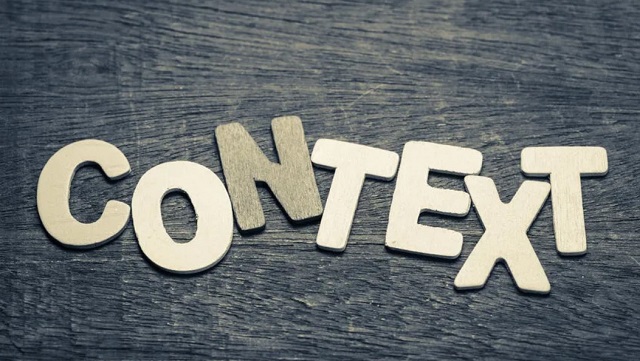Opinion/Editorial
WHAT’S YOUR CONTEXT?
What does it mean, as opposed to what does it say or how is it written? The human species developed an intensely refined form of verbal sound communication, linked with movement, and then refined further by written symbolic interpretation. Other animal species on the planet are known to communicate using rudimentary sound transmissions and receptions. At least one species echo-locates to likely communicate using sound pictures. The human ability to build, maintain and then even translate differential forms of the heard and written word is complex enough to take up entire volumes of analysis and conclusions. Suffice it here to say that nothing else humans, or any other known species has done in any area compares to the staggering gains returned from this homologation of what the species calls language. Inescapably entwined within the core of at the very foundational center of this wonderful gift lies a huge and constantly revealing conundrum.
Given that human language is easily the most powerful social tool every invented and developed, there exists a constant and obvious ability to mis-communicate as well as to communicate. Lies are endemic to the use of language. Denial of the transmission of lies is nearly as pervasive as lying itself. But the knowing transmission of unsupportable or deeply flawed information can be directly encountered and refuted. What becomes much more difficult to socially deal with is the use of language to effect perception and belief rather than the lying that might otherwise surface to be evaluated.
A great example of changing perception with the use of language in certain highly published phrases and words are those found on rapidly multiplying yard signs seen in and about the southern counties of Wisconsin lately. A group in Milwaukee, in response to well published cries of anger and rage expressed by large groups of the public about police officers throughout the nation killing unarmed black men at much greater rates than others, came together to attempt to counter public sentiment created by negative press about law enforcement. Also, deeply buried inside the foundations of this group was a belief that the ‘Black Lives Matter’ movement was racist, favoring blacks over whites. Yard signs could not be designed to state the beliefs of this group of conservative people because the messages written might subject the creators to accusations of racial prejudice. The tool that somehow came across the groups creative desk is called context. By coming up with a short statement purporting to do nothing other than support police officers but meaning much, much more, context was used to shift any blame for the reality of the message. Running right alongside of the new contextual message was the ability to deny what the message really meant. The writing on the yard sign today reads: “We Back the Badge.” At first coming upon one of these signs a normal citizen most probably wonders just who does not support the badge? Criminals? Convicts? Sex offenders, maybe? The message ostensibly appears as a general support statement about law enforcement in general. It is only in contest, explaining why it is necessary and popular to have the sign at all that the messages deeper meaning comes through. And that deeper meaning, darkly designed at the very foundation of racial difference, surfaces because there’s nowhere else for a reader’s mind to go.
Who are the people who decide to put these new yard signs up, generally with no other supporting signs of any kind? What citizen decides to place a placard in his or her front yard that, on its surface, seems to support local law enforcement while most other homeowners living nearby have no signs at all?
The signs are not really about law enforcement or badges. The signs use law enforcement and badges. The real message is contextually delivered and there’s little question about what that meaning is, although there will never be anything but outraged denials coming out of the committee that designed and fielded it.
What yard signs should one consider expressing deep-seated beliefs without necessarily alienating people around and also ones having messages that are totally deniable? Context can always be argued about and forever. “We Back the Badge,” as a yard sign might be a really good choice, in that regard, if your intent in putting it up is to confound the neighbors and passersby or maybe get them involved in the never-ending arguments. The sign: “Black Lives Matter” is equally capable of generating a lot of discussion about context.









